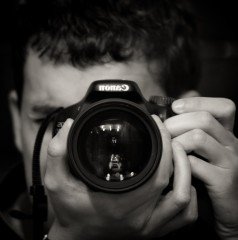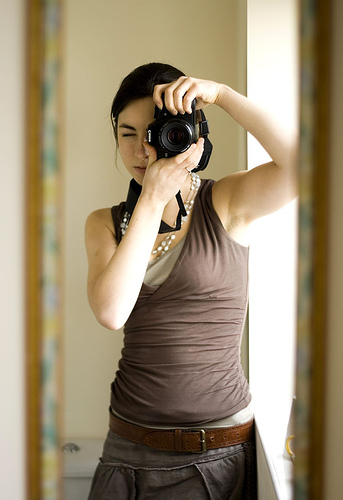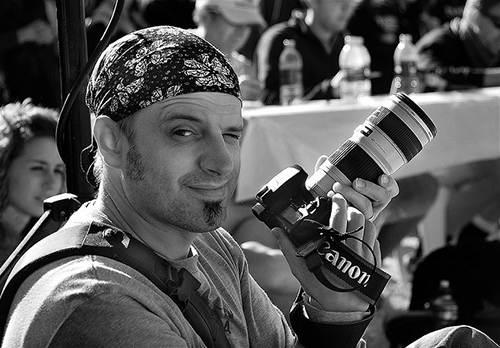
Camera to a photographer is what a brush is to the painter, an essential tool for giving shape (and tangible form) to his vision and creativity. Better the tool, the more control and precision it allows to bring your creativity to life. Our last article was on why your camera doesn’t matter. To keep the perspective balanced herein we take a look on the implication of a good camera and where it does make a difference. Even though your camera doesn’t make you good photographs, your camera does matter in portraying your imagination as per your creative vision. For the sake of improving your photographs, here is a small piece of advice — save money and gift yourself a DSLR. It scores over other digital cameras and leaves them ages behind owing to the following five reasons:
-
Sensor Size And Image Quality
One of the major reasons for upgrading to a DSLR (or even upgrading a DSLR) is better image quality. This image quality can’t be quantified in terms of interestingness or composition or creativity but in terms of noise, color, and light characteristics. The size of the camera sensor is a prominent factor is helping you portray the real-life tones, gradations, dynamic range etc. The picture quality or the image quality is directly related to the size of image sensor — bigger the sensor, more is the light collected and better the image quality. The larger sensor enables the camera to collect more light, which results in better exposure and excellent colors in your captures. Owing to the big sensor size the digital SLRs render sharp images even at high ISO. It is where the compact cameras fail to excel (of course, owing to small size of sensor).
-
Flexibility Of Using Multiple Lenses
Upgrading to a DSLR equips you with the flexibility of using multiple lenses or lens of your choice; depending on the subject you are photographing. The ability to change lenses offers a wide variety of opportunities to the hobbyist and the enthusiasts and comes in very handy. In fact as you develop as a photographer, you will find that it is very difficult to use the same lens for all photographs. The DSLR allows you to choose from a wide variety of lenses; prime (fixed-focus) lens, zoom lens, telephoto lens or wide angle lens — each of which is mastered for shooting specific purpose and scenes. For example, using a wide angle lens for landscapes enables you to cover more area of view than as covered by telephoto lens at the same distance. A telephoto lens on the other hand is useful for wildlife photography, where you want to fill the frame with the subject without getting close. Apart from this, there are lenses with some special features like image stabilization (or vibration reduction), soft focus, superior optics and internal zoom, which help in ultimately improving the picture quality.
-
Better Control Over Equipment
The digital SLRs offer more flexibility than any other camera; be it film cameras of olden days or the modern day compact cameras (mostly referred to as point and shoot camera). If you love to take photographs and have passion for exploring the world of photography, there is no match to DSLRs. It picks up from where your compact camera fail to capture your imagination. A DSLR enables you to frame your creativity, vision and imagination with flexibility and accuracy. All you need to know then is the basic photography concepts and a strong inclination towards experimenting with various techniques. Its fairly simple and easy to get the desired results with a DSLR, take control of the equipment and change various settings depending on the requirements.
- Attaining DOF: Depth of field is a critical issue with point and shoot cameras. This is one place where your camera does matter in capturing your imaginations as required. The compact cameras (and prosumers) do provide certain modes which internally controls the aperture and image settings, but fail to do justice with depth-of-field due to the limited range of aperture, shutter-speed, ISO. Amongst these, the aperture is responsible for introducing the “wow” factor in your photographs. Upgrading to a DSLR allows you to use a lens which allows you excellent range of aperture and helps you make the most of aperture settings; ranging from beautifully blurred backgrounds (or foreground) and creating dreamy bokeh effect to putting everything in focus with high DOF.
- Capturing Motion And Action: DSLR & DSLR-lenses offer an unmatched control over various settings, shutter speed being one of them. It offers a huge range of shutter-speeds to make capturing of motion and action possible. At the fastest shutter speed a DSLR can even freeze the actions and movement of a performer or a player.
- Long Exposures: DSLRs have an edge over any other camera owing to the list of features it offers. Another interesting feature which makes DSLRs stand distinguished from the rest of the crowd is its ability to make long exposures; either at slow shutter speed or with BULB mode on. The long exposures enable you to capture the flow of water, trails of lights, etc inducing a beautiful and surreal motion blur.
- Less Noise: Noise is a direct effect of sensor size or the pixel size. Compact cameras have small sensors which produce grainy effects even at low ISO (somewhere in the range of 400-800). This makes the compact cameras unsuitable for photographing in low ambient light. DSLRs on the other hand are able to generate clear and sharp images even at high ISO settings.
- Giving Professional Touch To Your Photographs: The last and the utmost important reason behind holding a DSLR in your hands is the desire to give professional touch to your photographs. Better picture quality, sharpness, depth of field, clarity of images ultimately lure a newbie to upgrade to the DSLR for adding a professional finish to their work.
-
Shooting In RAW
Compact cameras and point and shoot types process the image and store them as JPEGs. Whereas all the DSLRs provide an option for shooting in RAW format. RAW image file is the direct digital data from the camera sensor; it contains the data in raw form as collected by the camera sensor. RAW files are analogous to the negatives in film photography. It contains a lot of information — it preserves all the camera & lens metadata along with the image data and allows you to alter it during the post-processing. So other than the light and composition almost everything can be changed — the exposure curve, the contrast, sharpness, saturation, noise reduction or even the auto-mode settings.
-
Additional Features
DSLRs excel over other cameras owing to some outstanding features which it provides. The camera manufacturers aim to provide features which make the task of the photographer simple and easy. Various DSLRs offer various features. Some of the features which you will definitely miss in any other camera are:
- Ability To Accessorize: You can highly customize the DSLRs as per your requirements. Its extensibility through a wide range of accessories including hot shoe-mounted flash units, battery grips for additional power and grip, external light meters, filters, lenses and remote controls (comes in handy for wildlife photography) make the DSLRs a perfect equipment for exploring new and creative opportunities.
- Preview DOF: Apart from offering a huge range of aperture settings, some DSLRs also offer depth of field preview feature, which allows you to preview DOF before the final shot.
- Responsive Performance: DSLRs fall in the category of advance equipment and often offer faster and more responsive performance, with less shutter lag, faster auto-focus systems, faster frame rates and less processing time.
- Metering Modes: What a camera sees and captures is slightly different from what human eye views or perceives. The digital cameras meter the scene (interpret the light) and automatically adjust aperture, shutter-speed and ISO settings for optimal exposure, depending on the metering mode. All most all the DSLRs offer the flexibility of switching between various metering modes, so as to enable your camera to meter the scene on basis of some specific criteria.
Remember, all this technology is there to make your task easier. The camera’s sole purpose is to help you realize your creative vision. And all this technology remains un-utilized if you don’t develop the creative vision or the artistic talent of a photographer. So instead of comparing cameras and specs., take time grasping the photography-concepts and making your photographs better.
What do you like about your DSLR?




Sure, these are great. Don’t ignore the one reason not too upgrade: if you’re not going to carry it, you’re not going to take pictures with it.
DSLRs are heavy enough that most people will buy them then quickly tire of carrying them around.
They’ll also likely buy them with a kit zoom lens and never us another, eliminating the “Flexibility Of Using Multiple Lenses’ argument.
A LOT of people I know who’ve bought Canon Rebel T2i’s would, in my opinion, be better served by a G11/G12.
If you’re going to put sensor size on the table an S95 has a phenomenal sensor, and any DSLR that doesn’t have a full frame shouldn’t be considered a camera. It’s a toy.
That’s just my opinion mind you.
Thanks for the comment Darcy. You’re right, buying the DSLR when you just need a compact camera is a waste of money.